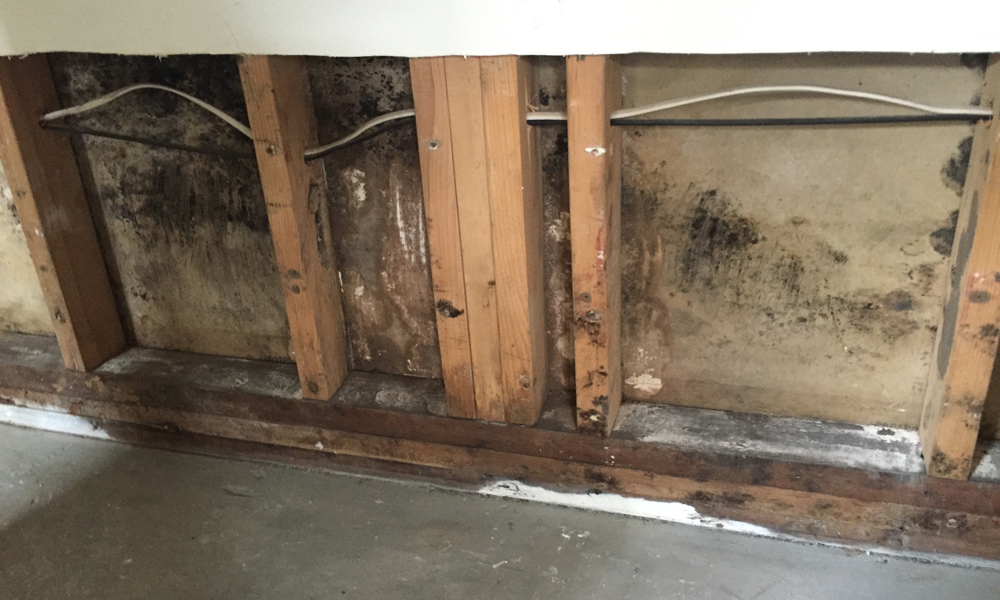Diamond Certified Experts: Mold Prevention and Remediation

Due to its potential health risks, a mold infestation should be dealt with promptly and correctly. Photo: NBE Property Restoration (2016)
Silent, it grows undetected. Hidden, it lurks beneath your floors and inside your walls. No, it’s not some alien from a science fiction movie—it’s mold! While less terrifying than an extraterrestrial invasion, mold is nonetheless a pervasive problem found in homes throughout the Bay Area. Due to its potentially serious health repercussions, combating mold requires a proactive approach, both in terms of prevention and dealing with it remedially. To shed some light on this important subject, we’ve asked four Diamond Certified Expert Contributors to weigh in with their professional knowledge of mold prevention and remediation.
Mold prevention
It’s well-known that the primary cause of mold is moisture, often as a result of damp, humid conditions, which is why the best way to prevent it is controlling your home’s humidity levels. During warmer times of year, simply opening some windows or running your air conditioner are typically adequate measures, but in winter, you may need to purchase a dehumidifier, which manually removes moisture from the air without having a cooling effect. Ventilation is especially critical in moisture-prone areas like kitchens, bathrooms and laundry rooms, so be sure to run the exhaust fan when cooking, bathing or running your dryer.
Even if your home doesn’t have humidity issues, there are still hidden areas where mold can thrive. Steve Spratt of HPS Palo Alto, Inc. points out a commonly overlooked one: front-loading washing machines. A front-loading washer’s rubber door seal has numerous folds where moisture can collect, which often leads to mold or mildew issues. To prevent these, Mr. Spratt recommends leaving your washer’s door open when it’s not in use and regularly cleaning the seal. You can also periodically run a wash cycle with a mildewcide tablet.
While mold prevention is usually a matter of routine proactivity, it’s not always that simple. For example, it sometimes comes as a secondary effect of water damage. To minimize this possibility, Erez Gilad of Reactic Restoration advises acting fast in the event of a leakage emergency. First, make sure you know the location of your home’s water main, which will allow you to stop a leak from a broken pipe or similar source. After stopping the leak, mop up as much standing water as you can and maximize ventilation by opening windows and doors. Keep in mind that in a considerable water damage situation, you’ll likely need professional assistance to dry out the structure if you want to avoid subsequent mold problems.
Mold remediation
Preventative measures are a good defense against mold, but if you find an existing infestation in your home, you’ll need to go on the offensive. If the situation isn’t too serious, you may want to try handling it yourself instead of calling a professional. However, as Dave Keith of NBE Property Restoration explains, there are some common mistakes you’ll need to avoid. For example, since mold loves moisture, people often to attempt to “dry out” a mold infestation by putting a fan on the affected area, but this actually does more harm than good. “Since mold is a spore, when you blow air on it, you’re blowing those spores all over the place, which can create a much worse problem,” says Mr. Keith. “A better way to diminish moist conditions is by using a dehumidifier, which will dry the area without causing further spore dissemination.”
Another common mistake Mr. Keith observes is improper use of bleach. “Bleach is an effective cleaner and sanitizer, but it’s also a toxic chemical with a byproduct that can be more harmful than the mold itself. To protect yourself, always dilute bleach to a 10 percent bleach/90 percent water solution.” Mr. Keith also warns that bleach only removes surface mold, so if your mold problem goes deeper (which many do), it’ll only provide a temporary fix.
If your efforts to combat mold on your own aren’t panning out, you’ll need to bring in a professional. As Mr. Gilad details, a remediation professional will approach mold removal using a rigorous four-step procedure. It starts with containment, wherein the affected area is sealed with plastic sheeting and put under negative pressure to contain and capture mold spores as the work is performed. Once the area is securely contained, the technicians will proceed to the demolition stage, opening up walls and other structural elements where mold has infested. Next, the remediation begins, as technicians sand everything down and place affected materials in sealed plastic bags to prevent cross-contamination. Finally, in the cleaning phase, microbial wipes and HEPA vacuums are used to thoroughly eradicate any trace of mold.
Regardless of the size and scale of your mold problem, you shouldn’t overreact. Due to the media hype regarding the dangers of mold, many people assume any mold they find represents an immediate, lethal threat. However, according to Rob Meyers of Environmental Remedies, Inc., the situation is seldom so dire. Out of the thousands of different mold strains in existence, only a few produce toxins, so it’s highly unlikely yours represents a life-threatening hazard. In other words, before moving your family into a hotel, call a professional to inspect your mold problem and assess the level of danger it poses.
Use Diamond Certified Resource to find top rated companies.
Local, Top Rated Diamond Certified Companies Related to Your Topic
Sonoma County Mold Removal & Repair Companies
Santa Clara County Mold Removal & Repair Companies
Napa County Mold Removal & Repair Companies
Marin County Mold Removal & Repair Companies
Related Articles
The Homeowner's Guide to Home Safety & Security
Get Expert Advice From Owners of Top Rated Local Companies
Become a Diamond Certified Preferred Member (Always Free)